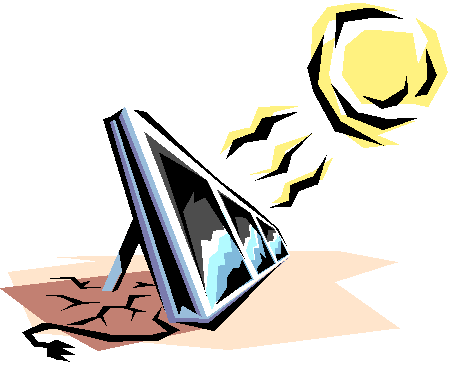|








| |
5. CONNECT SOLAR LOOP PIPING TO
THE POOL EQUIPMENT
The solar loop piping should be connected to your pool circulation
equipment after the filter and before the heater (if you have one).
- You want only filtered water going through your solar panels
- So there is no chance of debris clogging panels
- You want the solar system to preheat your gas or electric heater if
you want to use them simultaneously.
- If space is an issue, you will have to adjust the existing plumbing to
suit the following requirements:
Manual vs. Automatic Operation
Solar systems can only add heat to the pool if the panels are operated
when they are warmer than the pool water. Otherwise, the panels will
radiate heat from the pool into the atmosphere and cool the pool down. So,
generally you want to have water going through the panels only when the sun is
shining - between 10am and 4pm (give or take an hour depending on panels
orientation). You can accomplish this several ways:
- Put your pump on a timer so the system could only operate between
10 and 4.
- Or, if you run your pump longer than that up to 24 hours per day, you would have to:
- manually bypass the solar every afternoon and turn it back on every
morning
- Depending on weather conditions, you may need to do this during the
day as well.
- use an automatic control mechanism so the system turns itself on
as needed--recommended. See next section on Auto Controls
- Manual operation uses a manual gate or ball valve between the solar
feed and return tees that can be closed to force water through the panels or
opened to bypass the panels.
- We always recommend a good plastic ball valve over a plastic or brass
gate valve
- We suggest using a 3-way Pentair, Jandy, or Hayward valve
instead of either the feed or return tee as your manual diverter valve so
you could motorized it for auto operation if you wanted to later
without needing to replumb anything. Be careful to install 3-way
valve correctly according to the manufacturer. If looking at a 3-way valve
at the letter T, the water from your filter should enter the valve at
the bottom or common port schematically. Valve can actually be in any
configuration.
- Manual system can be relatively hassle-free in sunnier climates where it
is normally sunny during daylight hours and a time clock is used to limit
solar operation.
- We never recommend manual systems in cooler, cloudier area like west of the
NW Cascades or Hawaii because
weather conditions can dramatically affect system performance.
Solar loop Isolation and drainage
requirements
- Care should be taken to ensure the solar panels and piping are protected
from potential harm.
- Install drain valves wherever needed
- If you run your pool equipment at all during cooler weather, you should:
-
install ball valves in both the solar feed and return lines to be able to
isolate the solar loop completely.
- Don't rely on the 3-way valve in
the feed and a check valve in the return line. Check valves are notorious
for letting water by under low pressure.
- Install drain valve on the panel-side of these ball valves so the loop can be
drained
- Leave these drain valve open all winter.
- Be sure to shut-off your solar control (if you have one) when not in
use during the off-season or whenever the isolation ball valve are closed.
Copyright © 2001
ecosystems.
All rights reserved.
Page last updated:
May 28, 2014
|

